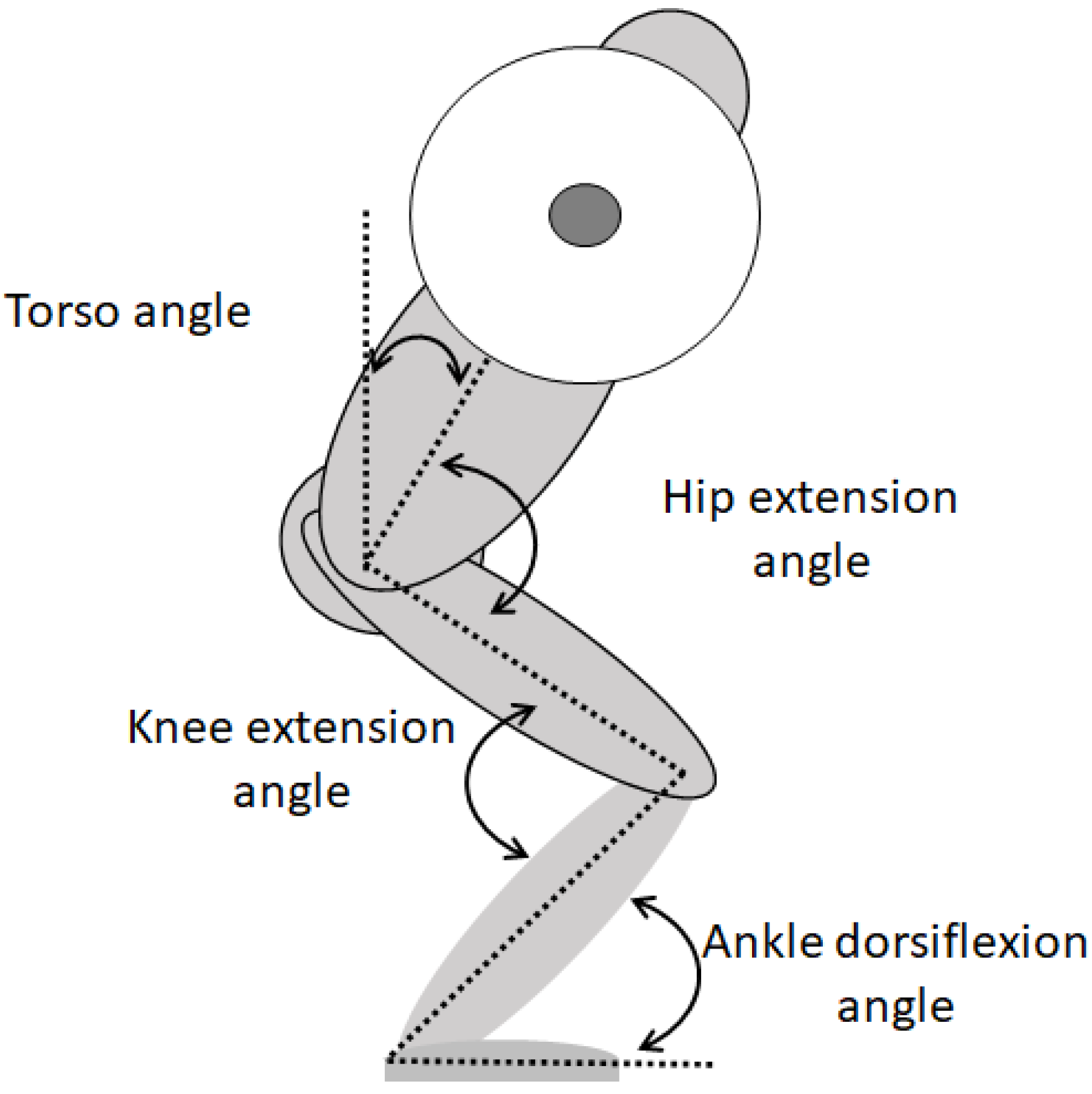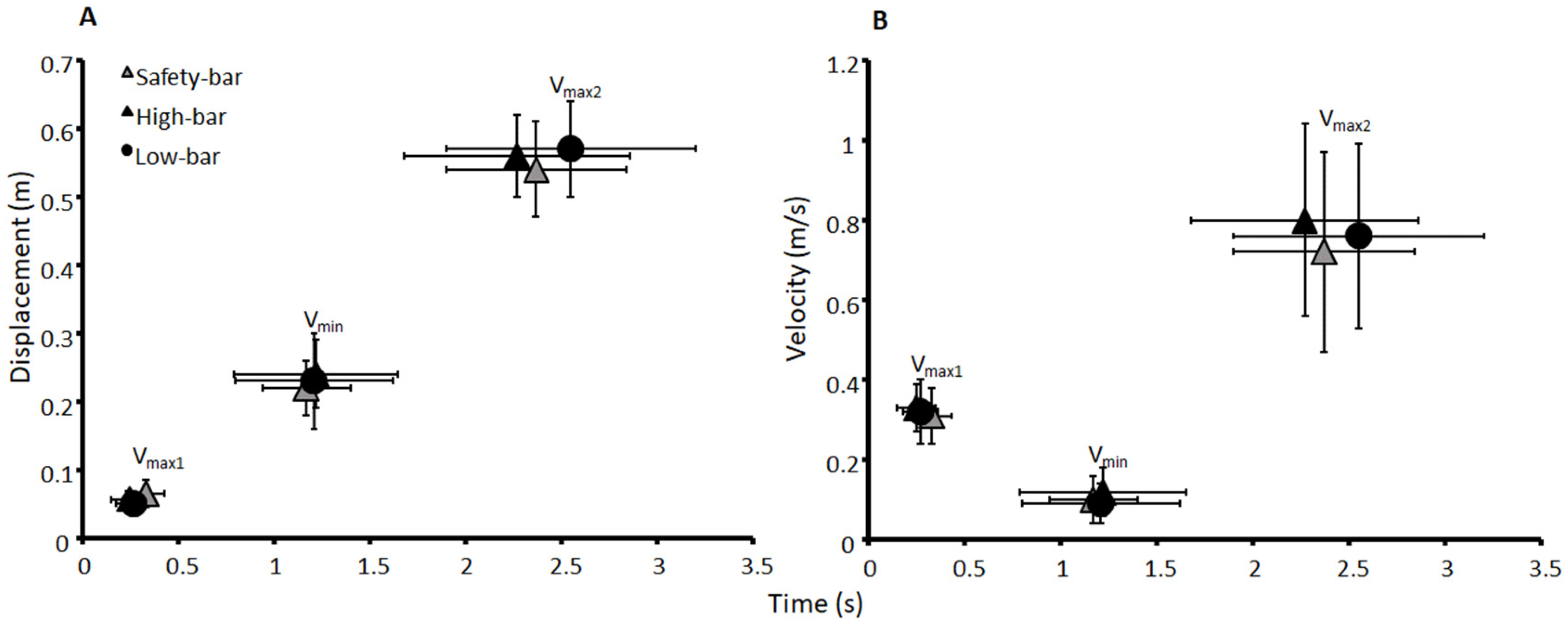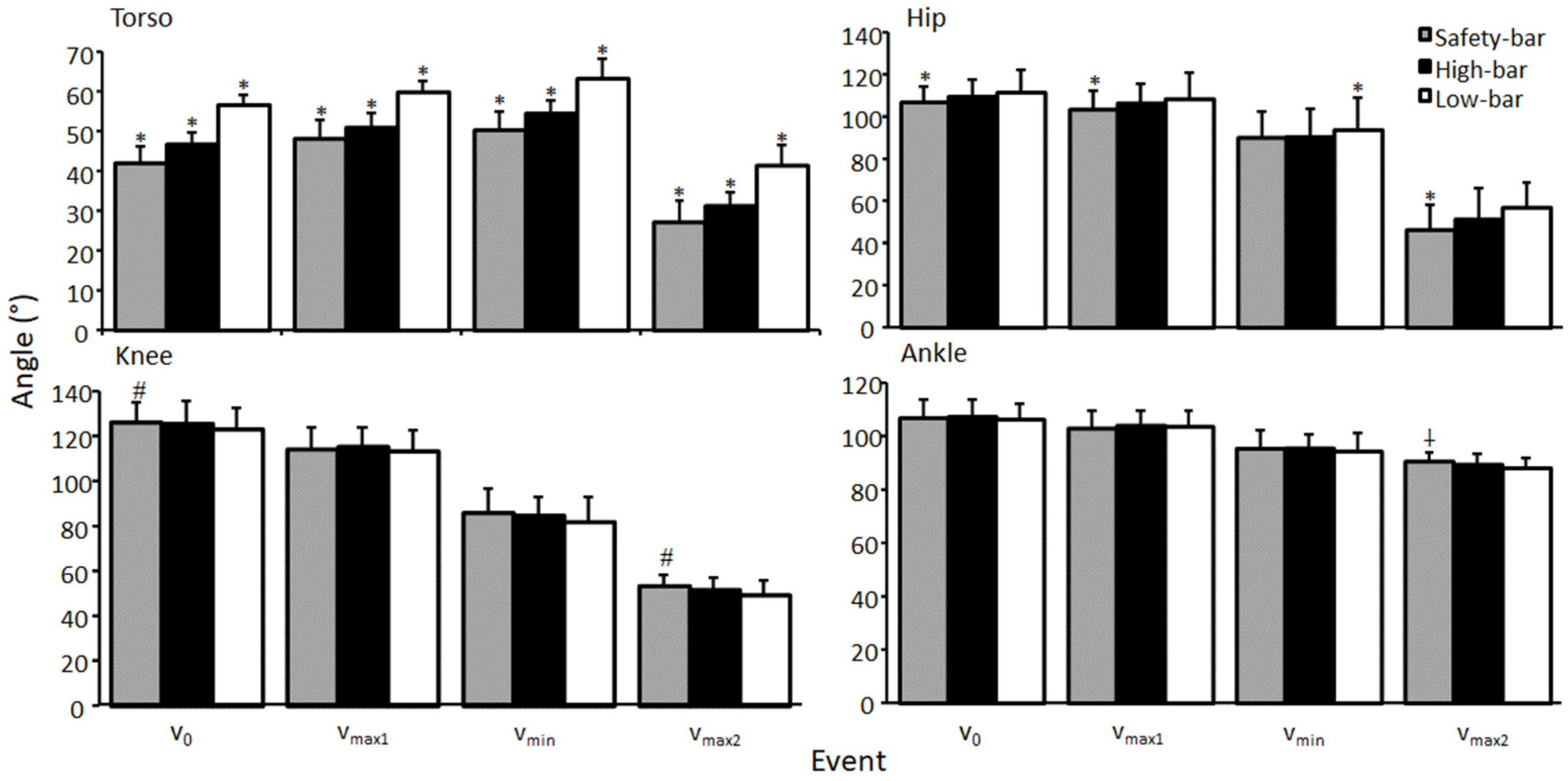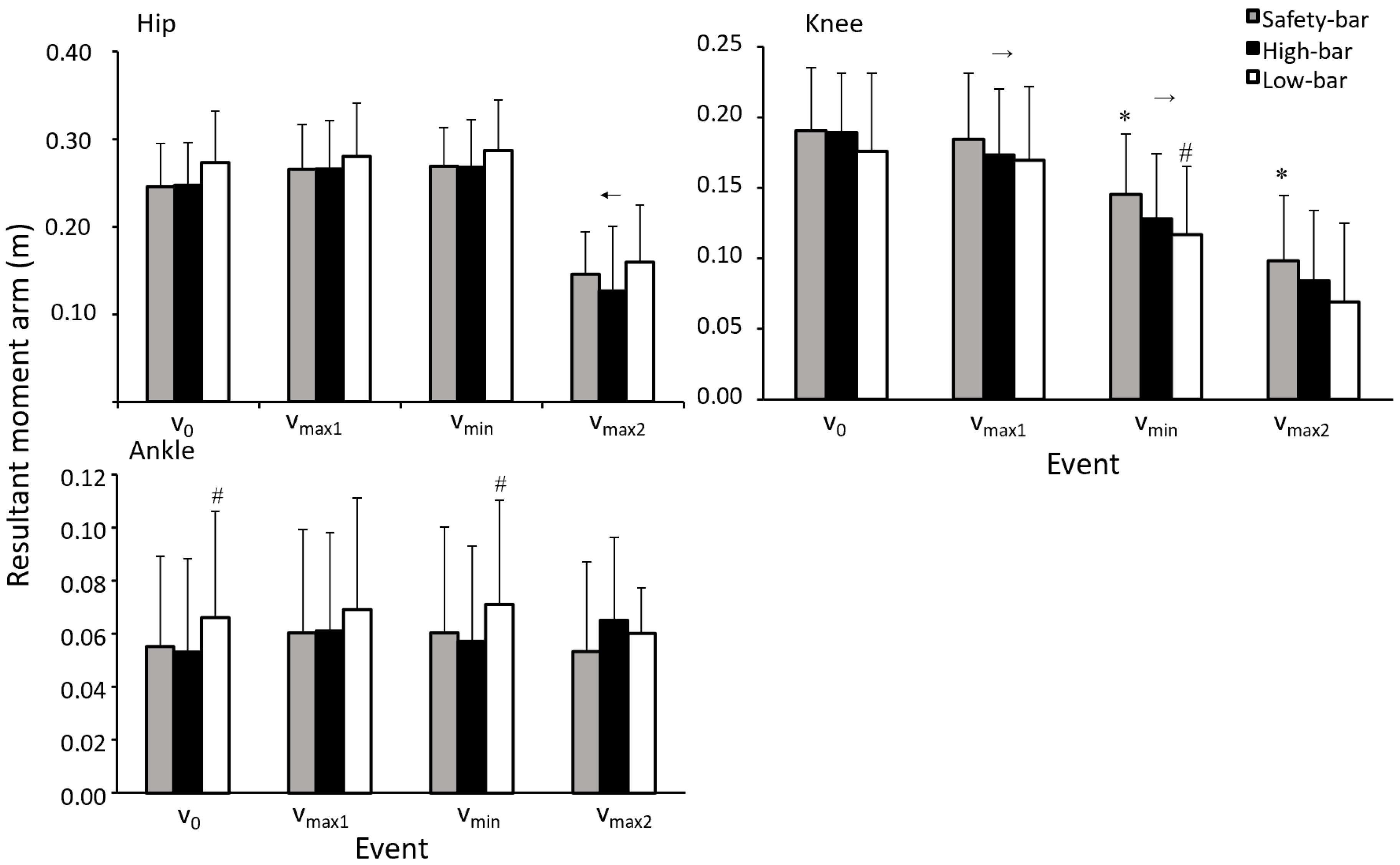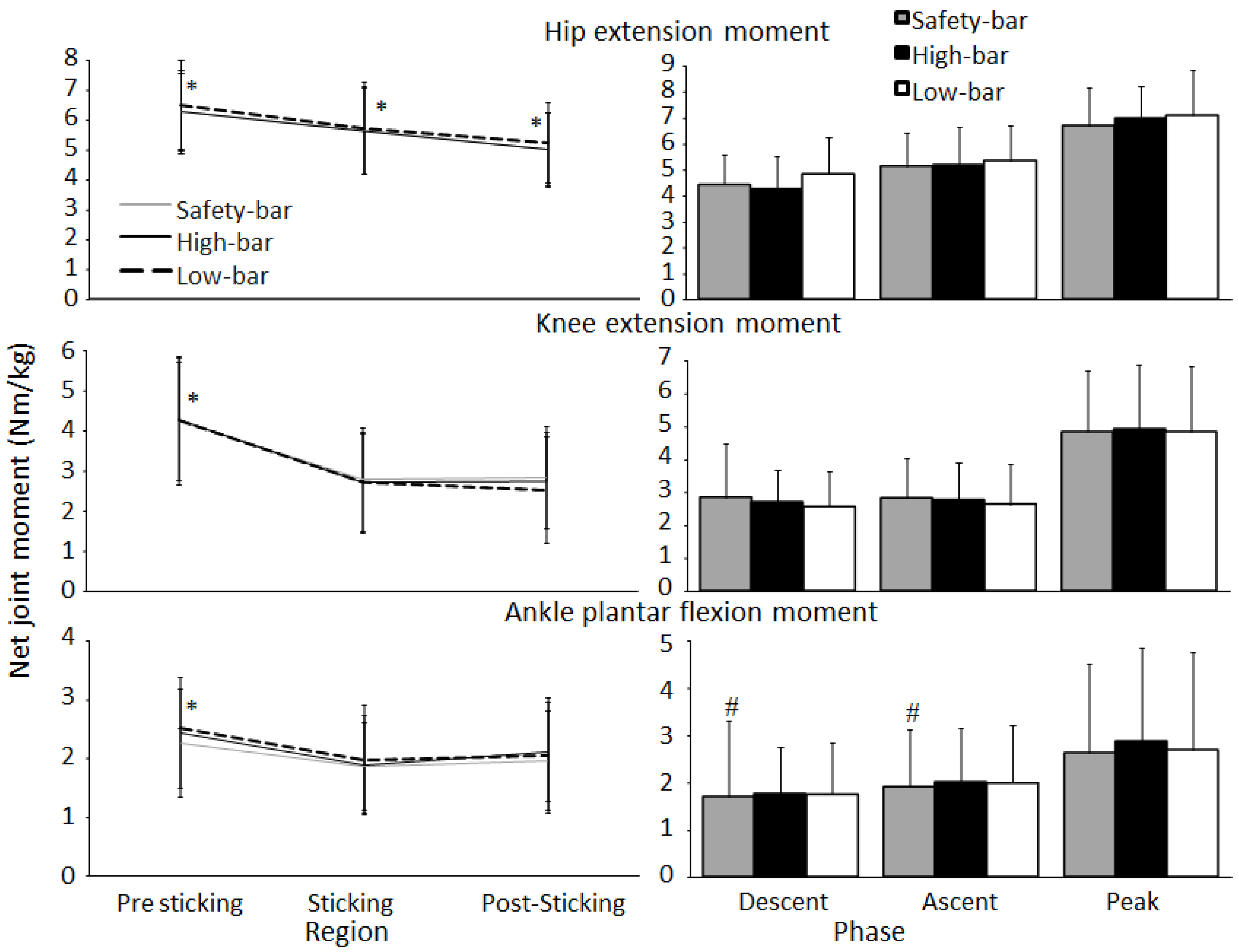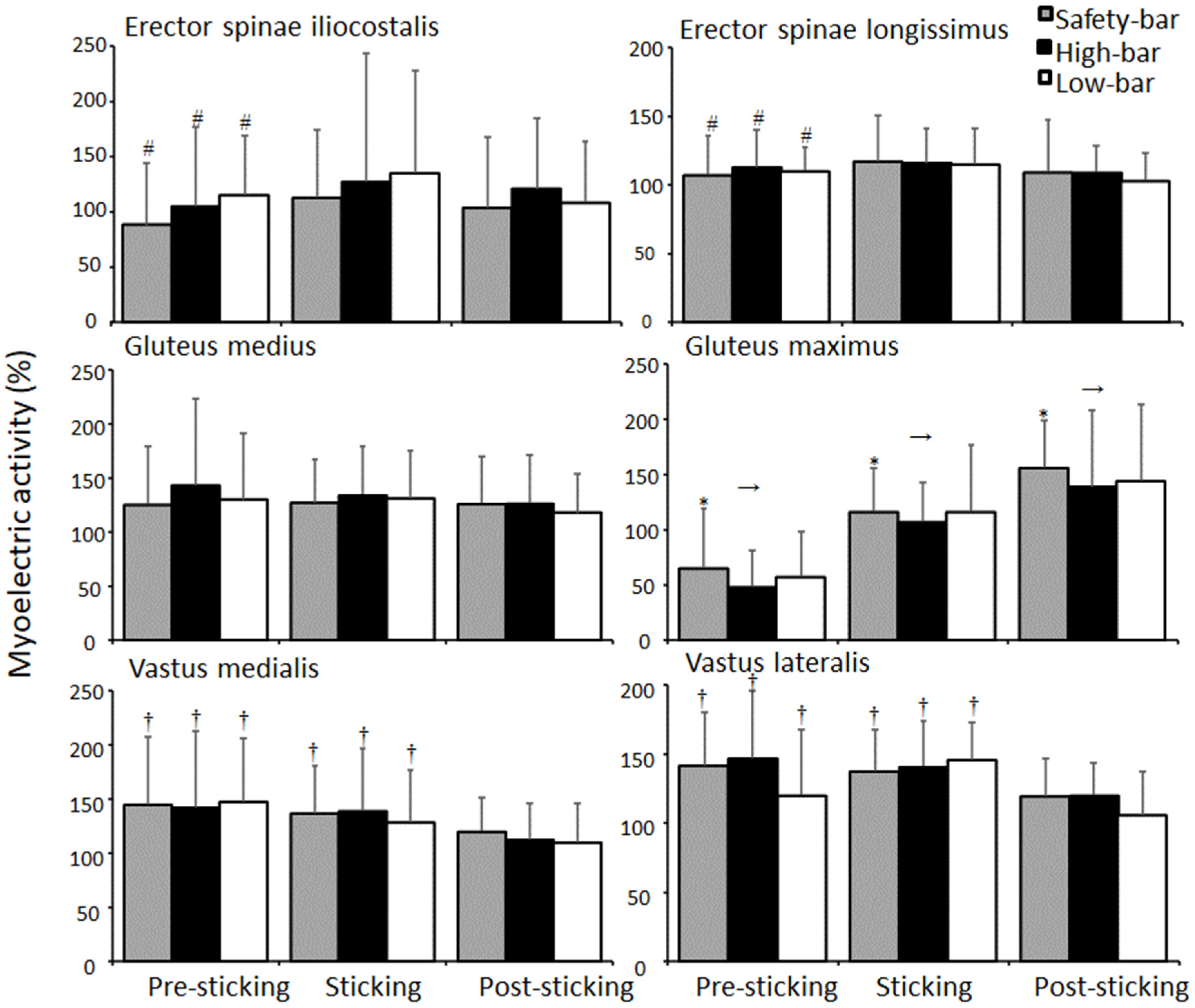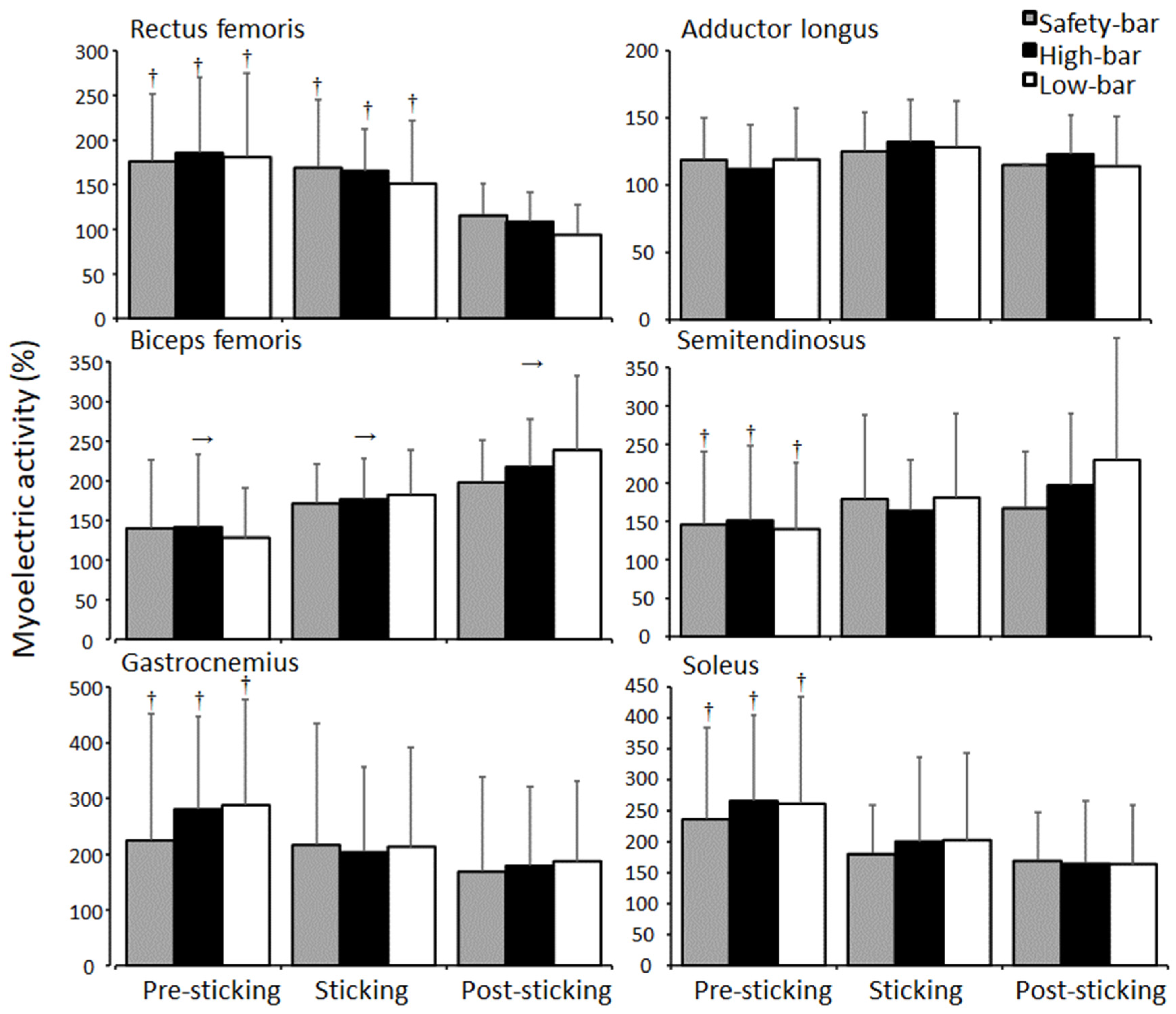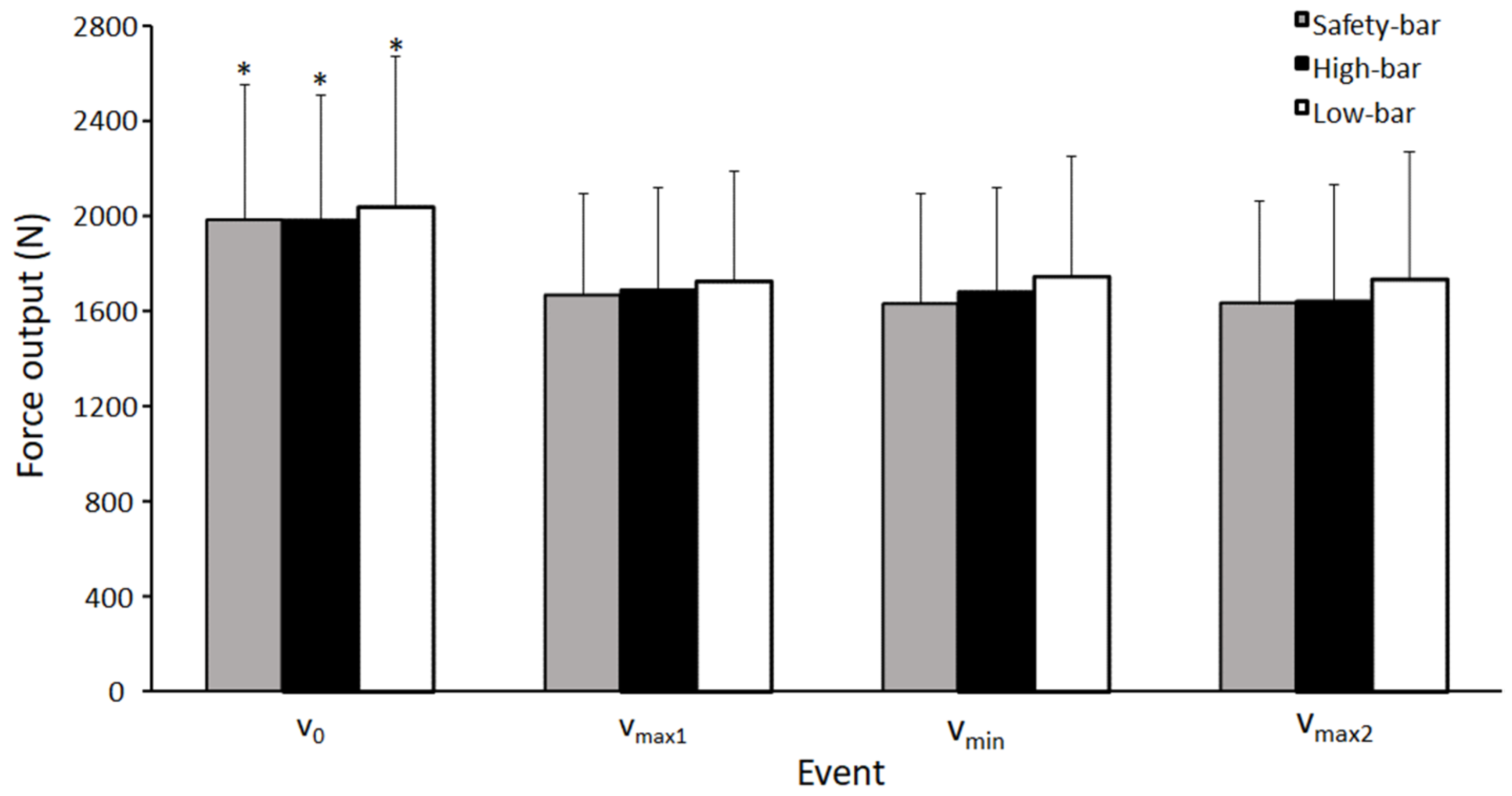1. Introduction
The back squat is a commonly used exercise by recreational lifters and athletes, both in training and competition [
1]. A back squat is performed by placing the bar on the back, either on top of the trapezius muscle or below the top of the trapezius muscle (high-bar and low-bar conditions, respectively). Only in recent years has squatting with a “safety-bar” (a cambered barbell with handles) become popular. Hence, only one study has investigated the safety-bar squats, finding that while it requires less shoulder mobility and puts less force on the shoulder and elbow joints, three-repetition maximum (3-RM) squats are 11.3% lower compared to squatting with a traditional barbell [
2]. Thus, the safety-bar could be seen as ineffective for maximizing strength gains, while being a useful alternative exercise since it places less stress on the lower back due to lesser torso inclination. However, Hecker, Carlson and Lawrence [
2] did not report if the Olympic back squat exercise was with a high-bar or a low-bar barbell placement. As stated, they found that squatting with a safety-bar produced a more upright torso, resulting in less hip flexion and a slight decrease in dorsiflexion. Furthermore, they found less myoelectric activity in the gluteus maximus, vastus medialis, rectus femoris, erector spinae, latissimus dorsi, middle trapezius, and the external obliques when squatting with a safety-bar compared to a traditional bar. The lower 3-RM during safety-bar squats could perhaps be explained in the shift of center of mass. The forward camber of the safety-bar position and the shift of center of mass could potentially make the exercise more difficult since it places greater demands to balance the center of mass for proper force production [
2].
When performing the barbell back squat with high-bar or low-bar barbell placement, studies often analyze lower-body kinematics [
3]. According to Glassbrook, Helms, Brown and Storey [
3], the main differences between high-bar and low-bar squats are a greater forward torso lean during the low-bar squat. With this forward lean, the force increases on the hip joint compared to the knee joint. This leads to a greater internal moment arm for the gluteus maximus and, therefore, increases the potential for lifting heavier loads with a low-bar position compared to the high-bar position [
3,
4]. For the knee joint, 11 of 14 studies showed greater knee flexion with the high-bar squat, resulting in a deeper bottom position [
3]. Glassbrook, Helms, Brown and Storey [
3] also reported differences between the high-bar and low-bar conditions in myoelectric activity, where forward lean in the low-bar squat often results in greater myoelectric activity in the posterior chain, while the greater knee flexion angles together with a more upright torso for the high-bar squat often result in greater quadriceps myoelectric activity.
When squatting with loads over 85% of 1-RM, a sticking region occurs during ascent of the squat [
5,
6]. The sticking region is where lifters have a higher chance of failing a squat [
7,
8]. The sticking region is one of the three regions of the ascent phase, which starts with a pre-sticking region (lowest barbell height: v
0) to the first located peak velocity (v
max1). The sticking region start from this point to the first located minimum velocity (v
min) in the ascent phase, right before the barbell accelerates again to the next peak velocity of the barbell (v
max2), which is the post sticking region. It is suggested that is there a co-contraction between the quadriceps and the gluteus muscles, which causes a deceleration in the ascent and thereby the sticking region in the back squat [
7]. This may occur due to less favorable joint angles and longer moment arms of the muscles involved. Furthermore, van den Tillaar, et al. [
8] investigated the effects of high-bar and low-bar squats on joint kinematics and myoelectric activity around the sticking region. The authors found no significant differences in barbell and joint kinematics around the sticking region between techniques when absolute load, depth, and stance width were controlled. However, they observed an increase in myoelectric activity in the rectus femoris, vastus medialis, and the lower part of the erector spinae with the high-bar position compared to the low-bar position.
To the authors’ best knowledge, safety-bar squats have not previously been compared to high-bar and low-bar squats. Therefore, the purpose of this study was to compare barbell and joint kinematics, kinetics, and myoelectric activity of the safety-bar squat with the high-bar and low-bar squat around the sticking region. We hypothesized that squatting with a safety-bar or high-bar would produce a more vertical torso position due to less peak hip flexion and a forward shift in center of mass, creating greater knee joint moments and thereby, greater myoelectric activity during these squat conditions for the knee extensor muscles. We further hypothesized that the low-bar squat would result in more hip flexion, creating greater hip joint moments and hip extensor myoelectric activity compared to the safety-bar condition.
3. Results
The average 3-RM load lifted by participants was 91 ± 30.1 kg, 93.4 ± 9 kg, and 97.6 ± 30.5 kg with the safety-bar, high-bar, and low-bar squat conditions, respectively. The average 3-RM loads lifted for men were 116.1 ± 14.5 kg, 118.5 ± 12.7 kg and 123.3 ± 12.1 kg with the safety-bar, high-bar, and low-bar squat conditions. For women, the average 3-RM loads lifted were 71.8 ± 23.3 kg, 74.5 ± 22.4 kg, and 78.4 ± 25.3 kg with the safety-bar, high-bar, and low-bar squat conditions. A significant effect of load lifted was found between the different squat conditions and sexes (F ≥ 7.8,
p ≤ 0.006, η
2 ≥ 0.55). Men lifted significantly more with the high-bar, low-bar, and safety-bar condition compared with women (
p ≤ 0.001). The participants lifted significantly more with the low-bar condition compared with the two other squat conditions (
p ≤ 0.012). Also, the participants lifted significantly more load with the high-bar condition compared with the safety-bar (
p ≤ 0.007). No significant differences were observed between the squat conditions or sexes in velocities, distances, or timing at the ascent phase of the events around the sticking region (F ≤ 3.4,
p ≥ 0.059, η
2 ≤ 0.19) (
Figure 2).
A significant effect of torso and hip flexion angle was found during all events (F ≥ 5.9,
p ≤ 0.023, η
2 ≥ 0.31). The low-bar condition had the greatest torso angle followed by the high-bar and safety-bar conditions during all events (
p ≤ 0.023) (
Figure 3). For hip flexion angles, post-hoc tests showed that the participants performed less hip flexion for the safety-bar squat in v
0, v
max1, and v
max2 compared to the other squat conditions (
p < 0.021), while in v
min, the low-bar condition had greater hip flexion than the other conditions (
p ≤ 0.026). For knee extension angles, a significant effect was found for the events v
0 and v
max2 (F ≥ 4.5,
p ≤ 0.02, η
2 ≥ 0.24), while no significant effects occurred during v
max1 and v
min (F ≤ 2.9,
p ≥ 0.071, η
2 ≤ 0.17). Bonferroni post-hoc tests revealed that the participants squatted with greater knee extension when using the safety-bar condition compared to the low-bar condition at v
0 and v
max2 (
p ≤ 0.019). A significant effect of squat condition was found for ankle dorsi flexion angle (F ≥ 6.2,
p ≤ 0.004, η
2 ≥ 0.31). Bonferroni post-hoc tests revealed that the safety-bar condition had greater ankle dorsiflexion than the low-bar condition in v
max2 (
p = 0.004). No other significant difference was found in hip extension, knee extension and ankle dorsi flexion angle for all squat conditions (F ≤ 1.2,
p ≥ 0.329, η
2 ≤ 0.08). For knee valgus there was a significant sex difference found at v
max2 in the high-bar and safety-bar conditions (F ≥ 1.93,
p ≤ 0.04, η
2 ≥ 0.31) where men had higher knee valgus than women (
Figure 4). No other significant differences were found between men and women for any joint kinematic measurements for any squat conditions during any events (F ≤ 3.13,
p ≥ 0.08, η
2 ≤ 0.19).
No significant effect of squat condition was found for moment arms in the hip during the different events (F ≤ 1.66, p ≤ 0.21, η2 ≤ 0.11). A significant effect of squat condition was found for mean knee moment arms at v0, vmin, and vmax2 (F ≥ 4.52, p ≥ 0.02, η2 ≥ 0.24). Post-hoc tests showed that at vmin and vmax2 the safety-bar condition had a larger moment arm compared to the low-bar condition (p ≤ 0.006). However, no significant differences were found at v0 and vmax1 for knee moment arms (p ≥ 0.112). Furthermore, a significant difference at vmin was found, with a greater knee moment arm with the high-bar condition compared to safety-bar (p = 0.025). No further significant differences were found between the safety-bar and high-bar conditions for knee moment arms during the different events (p ≥ 0.08). A significant effect of squat condition was found for mean ankle moment arms at v0 and vmin (F ≤ 3.63, p ≥ 0.04, η2 ≤ 0.21). A post-hoc test showed significant differences in ankle moment arms between the high-bar and low-bar conditions at v0 and vmin (p ≤ 0.032), where the low-bar condition had a greater ankle moment arm than the high-bar.
A significant effect of events on the hip moment arm was also found (F ≥ 131.9,
p ≤ 0.001, η
2 ≥ 0.9). Bonferroni post-hoc tests revealed that the hip moment arm decreased significantly from v
min to v
max2 for all squat conditions (
p ≤ 0.001,
Figure 5). When analyzing the knee moment arm during the different events, a significant effect of the event was found (F ≥ 90.85,
p ≤ 0.001, η
2 ≥ 0.86). Post-hoc tests revealed that the knee moment arm decreased from v
max1 to v
min and v
max2 for all squat conditions (
p ≤ 0.001). However, no other significant interactions with events were found for mean hip, knee, or ankle moment arms for any squat conditions (F ≥ 0.74,
p ≥ 0.53, η
2 ≥ 0.05).
No significant effect of squat condition was found for mean or peak hip extension or ankle plantar flexion moments during the ascent (F ≤ 2.4,
p ≥ 0.111, η
2 ≤ 0.16). However, a significant effect of sticking region was found (F ≥ 15.4,
p ≤ 0.001, η
2 ≥ 0.252). Bonferroni post-hoc tests revealed that the hip extension moment decreased from region to region for all squat conditions (
p ≤ 0.001), while the plantar flexion and knee extension moment decreased from the pre-sticking to the sticking and post-sticking regions (
p ≤ 0.014) (
Figure 6). Furthermore, a significant effect between conditions was found upon the mean descent and ascent knee extension moment (F ≥ 3.6,
p ≤ 0.042, η
2 ≥ 0.20), but not for the peak knee extension moment (F = 0.14,
p = 0.78, η
2 = 0.01). Post-hoc tests showed that the knee extension moment was greater when squatting with a safety-bar condition than with the low-bar condition during both the descent and ascent phases (
p ≤ 0.042).
No significant effects were found for squat condition on myoelectric activity except for the gluteus maximus (F = 3.9,
p = 0.039, η
2 = 0.16). Squatting with a safety-bar led to greater myoelectric activity of the gluteus maximus than squatting with the high-bar technique (
p = 0.024), with no differences between the other conditions (
p ≥ 0.05). Furthermore, a significant effect of the region was found for myoelectric activity of the erector muscles, gluteus maximus, quadriceps, hamstring, and shank muscles (F ≥ 3.9,
p ≤ 0.039, η
2 ≥ 0.16). No significant differences were found in myoelectric activity between the regions for the gluteus medius or adductor longus muscles (F ≤ 1.9,
p ≥ 0.166, η
2 ≤ 0.76) (
Figure 7). Bonferroni post-hoc tests revealed that both erector muscles increased myoelectric activity in the sticking region for all squat conditions (
p ≤ 0.02). Furthermore, the gluteus maximus and biceps femoris myoelectric activity increased during each region (
p ≤ 0.028), while the semitendinosus increased myoelectric activity from the pre-sticking to the post-sticking region for all three squat conditions. The quadriceps myoelectric activity decreased from the pre-sticking and sticking region to the post-sticking region (
p ≤ 0.011), while the gastrocnemius and soleus decreased myoelectric activity from the pre-sticking to the post-sticking region (
p ≤ 0.028) (
Figure 8). A significant effect of sexe was found for the gluteus maximus during the safety-bar and high-bar conditions (F ≥ 6.1,
p ≤ 0.008, η
2 ≥ 0.36), where post-hoc tests revealed a higher gluteus maximus myoelectric activity in the safety-bar condition for men (pre-sticking: 83.7 ± 40.7%, sticking: 150.6 ± 65.4%, and post-sticking: 203.6 ± 103%) than women (pre-sticking: 53.5 ± 30.7%, sticking: 93.3 ± 37.7%, and post-sticking: 191.1 ± 43.4%) in all regions (
p ≤ 0.04). For the high-bar condition, a significant difference in the post-sticking region was observed, where higher myoelectric activity in the gluteus maximus was observed for men (130.1 ± 19.8%) compared to women (102 ± 40.1) (
p = 0.046). No other significant differences were found in myoelectric activity between the sexes for the other muscles in any region during any squat condition (F ≥ 1.9,
p ≤ 0.166, η
2 ≤ 0.09).
No significant effect of squat condition was found for mean force output at the different events (F ≤ 2.57, p ≥ 0.09, η2 ≤ 0.19). However, a significant interaction between events was found for force output between the different squat conditions (F ≤ 30.56, p ≥ 0.001, η2 ≤ 0.74), where post-hoc tests showed that force output decreased from v0 to all other events for all squat conditions (p ≤ 0.001). No other significant differences were found for force output in the other events for any squat condition (p ≥ 0.17).
4. Discussion
The aim of the study was to compare barbell and joint kinematics, kinetics, and myoelectric activity of the safety-bar condition with the high-bar and low-bar squat around the sticking region. The main findings were that the participants lifted the least load with the safety-bar followed by the high-bar and low-bar squat. Also, greater myoelectric activity of the gluteus maximus was observed during the safety-bar squat compared to the high-bar squat. In addition, differences were found in joint kinematics for the knee extension moments between the safety-bar and the low-bar squat. Finally, men had higher myoelectric activity in the safety-bar condition for the gluteus maximus during all sticking point regions in comparison with women, and more knee valgus than for women at vmax2.
No significant differences were observed between the squat conditions in barbell kinematics at the ascent phase or the events around the sticking region, and the findings for barbell kinematics were similar to previous studies investigating the sticking region in back squats [
8,
12,
17,
18,
19,
20]. Performing the safety-bar squat allowed the most upright torso position followed by the high-bar and then the low-bar squat, which is in agreement with Hecker, Carlson and Lawrence [
2]. The more upright torso angle may be ideal for decreasing the shear forces in the lower back [
21], when performing a safety-bar squat. The participants performed the safety-bar squat with less hip flexion at v
0, v
max1, and v
max2 compared to the other squat conditions, while at v
min, the low-bar condition had greater hip flexion than the other squat conditions. Previous studies comparing high-bar and low-bar squats reported similar results, where the low-bar condition had a greater torso angle compared to the high-bar condition [
22,
23,
24]. Since the low-bar placement reduces the hip moment arm, it results in a greater torso inclination to produce the same moment around the hip joint (
Figure 3). This causes a more anterior displacement of the center of pressure, which is visible in the increased moment arm of the ankle (since all squats were maximal lifts, the hip moments were maximal). The center of pressure is the total pressure acting on a body and causes a force that acts through that point. A small difference between the high-bar and safety-bar conditions is caused by moving the arms forward, which would theoretically cause an increased moment arm. However, this does not occur likely due to the combination of a lower load lifted during safety-bar squats and/or a lower moment arm due to a more upright position (
Figure 5). This change of angles to establish the same hip moment causes a more anterior projection of the center of pressure, which is apparent when viewing the longer moment arm in the ankle joint in the low-bar condition compared with the other two squat conditions. This anterior projection produces a lower moment arm on the knee joint, which increases during the safety-bar condition (
Figure 5).
The gluteus maximus was the only muscle that showed significant myoelectric differences between the high-bar and safety-bar conditions. This likely occurred due to a more upright position in the safety-bar condition. This upright position during the safety-bar condition may have resulted in more ideal joint angles putting the gluteus maximus in a better position to improve its force-length properties (
Figure 7). As previously discussed, this is also thought to be one of the reasons for the sticking region’s existence. Since the gluteus maximus could not be used early in the pre-sticking region due to the force-length relationship, the quadriceps may be emphasized more at the start of the lift. Consequently, the safety-bar condition produces more myoelectric activity for the gluteus maximus with less load lifted. This is an interesting finding, which is in contrast with the finding by Hecker, Carlson and Lawrence [
2], where lower myoelectric gluteus maximus activity was found for the safety-bar squat compared to a traditional barbell squat. However, Hecker, Carlson and Lawrence [
2] performed both conditions at equal absolute loads, which may have altered the EMG comparison.
The myoelectric activity of erector muscles increased in the sticking region for all squat conditions, while myoelectric activity increased during each region for all squat conditions for the gluteus maximus and biceps femoris (
Figure 7). The quadriceps’ myoelectric activity decreased from the pre-sticking and sticking region to the post-sticking region, while the gastrocnemius and soleus increased myoelectric activity from the pre-sticking to the post-sticking region for all three squat conditions (
Figure 8). The findings are in accordance with earlier studies [
8,
12,
17,
18,
19,
20,
25]; however, the bi-articular rectus femoris muscle, which is a hip flexor and knee extensor, had high myoelectric activity in the pre-sticking region for all squat conditions, which is dissimilar to the results from Robertson, et al. [
26]. They observed that the rectus femoris’ myoelectric activity did not change during the entire ascent phase of the lift. However, the present study compared 3-RM squats, while Robertson, Wilson and Pierre [
26] analyzed squats at 80% of 1-RM, which may alter the demands on different muscles. Furthermore, we observed increases in biceps femoris myoelectric activity during the pre-sticking to the post-region for all squat conditions (
Figure 8), possibly contributing to the sticking region due to this co-contraction of the knee extensors and flexors. No differences were found for adductor longus or gluteus medius myoelectric activity between conditions or regions (
Figure 7 and
Figure 8). This may have occurred because the rotation angle for the foot was controlled between the squat conditions after initial participant self-selection. Therefore, it is possible that adductor longus myoelectric activity is impacted more by the hip rotation angles than barbell placement.
When investigating the joint moments during the different regions of the sticking phase, the largest hip, knee, and ankle moments were found at v
0 for all three squat conditions (
Figure 6), which is in line with the findings by Robertson, Wilson and Pierre [
26]. The hip moment decreased from the pre-sticking to the post-sticking region for all conditions (
Figure 6), which was also similar to the results of Robertson, Wilson and Pierre [
26]. Peak knee and ankle moments were also the highest at the bottom position; however, and then decrease through the subsequent regions in all three squat conditions. Since the peak hip, knee, and ankle moments are all at the bottom position, it could be thought that this would be the hardest position since it is the weakest point to exert force. However, peak knee moments occur at v
0 and v
max1 during the ascent phase, which may not impact squat performance to a considerable degree since the transition from eccentric to concentric at the bottom position of the squat is aided by elastic/stretch reflex contributions to force production. This is demonstrated by greater acceleration occurring during the transition to concentric following the eccentric. Afterwards, force remains similar throughout the ascent due to similar accelerations at all subsequent events (force = mass
× acceleration) (
Figure 9). The relationships between moments and myoelectric activity around the sticking region provides further insight regarding the muscular contributions during these phases.
Peak hip moments occurred at v
0 and v
max1, while the myoelectric activity of the gluteus maximus was lower in the pre-sticking region than in the sticking region and the hip moment decreased in the post-sticking region (
Figure 6). It seems that the gluteus maximus is an agonist in the sticking region, indicated by increased myoelectric activity from the pre-sticking to the sticking region. However, quadriceps myoelectric activity decreased from the pre-sticking and sticking region to the post-sticking region for all squat conditions, indicating that during the first part of the ascent, the quadriceps are the prime movers. The ascent phase of the lift starts with the quadriceps muscles and soleus performing knee extension and plantar flexion, which decreases around the lowest velocity time point (v
min), where the gluteus muscles and hamstrings increases their myoelectric activity. The reason for the gluteus muscles’ low activity at the start of the ascending phase is most likely due to the large muscle length and moment arms, causing a mechanically poor position to exert force (
Figure 9). Also, our findings showed that gluteus maximus myoelectric activity first peaked in the post-sticking region, indicating that the muscle’s capability to exert force and contribute to the hip extensor moment may not be optimal during the sticking region even if the hip extensor moment demands is large in this region. This coincides with the findings from van den Tillaar, Kristiansen and Larsen [
7], who found that the gluteus maximus peaked in myoelectric activity first at 0.25 m barbell height in 1-RM Smith machine squats, which is where the post-sticking region began for all squat conditions in our study. Therefore, our results show that the combination of large hip moments and a disadvantageous force production position for the gluteus maximus may be a notable contributor to the sticking region, independent of barbell placement.
There were two interesting differences found between the sexes. First, there was a difference in myoelectric activity for the gluteus maximus between sexes, in which the gluteus maximus in the safety-bar condition for all regions was higher in activity for men and can be an important variable for the difference in load lifted. Second, there was a higher knee valgus for men compared to women, which can come from differences in certain movement characteristics between the sexes. Between men and women there are some differences in hip anatomy that are worth mentioning, which may help explain differences in knee valgus. For instance, the female pelvis is generally shorter and wider than the male pelvis, which is taller and narrower [
27,
28]. Also, men tend to have less hip range of motion compared to women, which can lead men to have movement compensations when working through a full range of motion [
29,
30]. Due to anatomical and neuromuscular factors, greater knee valgus (knee moving inwards) for women than for men is often observed during squatting movements [
31]. Women often have greater lumbar lordosis angles at 7–13 degrees and standing sacral slope [
32,
33]. This places men’s and women’s glutes in different positions, and suggests that the female lumbar spine (on average) has more range of motion. While we observed a greater valgus in men compared to women, seemingly in contrast with previous research, it is possible that the observed difference may have come from the standardized stance of 0.7 times horizontal acromion length. Since men have longer distances between their acromions compared to women, this could lead to greater relative stance widths. With smaller hips, a harder time moving through the range of motion, and a greater absolute stance width, this may have caused more knee valgus among men. Also, the observation of greater knee valgus with increasing stance width is supported by Lahti, et al. [
34], who found greater knee valgus with wide stance compared to narrow stance. This is a limitation of the study and therefore, future studies should use hip width to determine the stance width when comparing kinematics and kinetics between the sexes.
